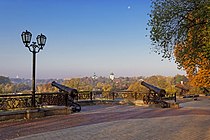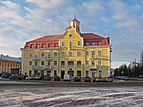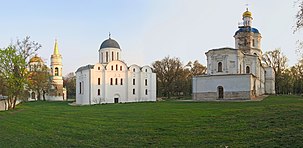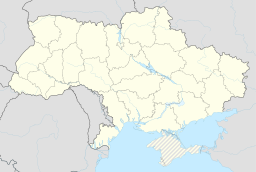Chernigiv
| Chernihiv (Чернігів) Chernigov (Чернигов) |
|||||
|---|---|---|---|---|---|
| City | |||||
     
From top, left to right: Trinity Monastery, Catherine's Church, fortress guns on the Val, Krasna square, Hotel "Desna" building, and view of ancient Chernihiv with Transfiguration, Borys and Hlib Cathedrals and Chernihiv Collegium
|
|||||
|
|||||
| Nickname(s): City of Legends | |||||
| Location of Chernihiv in Ukraine | |||||
| Coordinates: 51°30′0″N 31°18′0″E / 51.50000°N 31.30000°ECoordinates: 51°30′0″N 31°18′0″E / 51.50000°N 31.30000°E | |||||
| Country |
|
||||
| Oblast | Chernihiv Oblast | ||||
| Municipality | Chernihiv municipality | ||||
| Founded | 907 | ||||
| City Status | 907 | ||||
| Government | |||||
| • Mayor | Vladyslav Atroshenko (Petro Poroshenko Bloc "Solidarity") | ||||
| Area | |||||
| • Total | 79 km2 (31 sq mi) | ||||
| Elevation | 136 m (446 ft) | ||||
| Population (2015) | |||||
| • Total | 294,727 | ||||
| • Density | 1,547/km2 (4,010/sq mi) | ||||
| Postal code | 14000 | ||||
| Area code(s) | (+380) 462 | ||||
| Vehicle registration | CB / 25 | ||||
| Website | chernigiv-rada.gov.ua | ||||
Chernihiv (Ukrainian: Чернігів Ukrainian pronunciation: [t͡ʃɛrˈnʲiɦiw]) also known as Chernigov (Russian: Черни́гов; IPA: [tɕɪrˈnʲiɡəf], Polish: Czernihów), a historic city in northern Ukraine, serves as the administrative center of the Chernihiv Oblast (province), as well as of the surrounding Chernihiv Raion (district) within the oblast. Administratively, it is incorporated as a city of oblast significance. Population: 294,727 (2015 est.)
Chernihiv stands on the Desna River to the north-north-east of Kiev.
The area was served by Chernihiv Shestovitsa Airport, and during the Cold War it was the site of Chernigov air base.
Chernihiv was first mentioned in the Rus'-Byzantine Treaty (907) (as Черниговъ (Chernigov)), but the time of establishment is not known. According to the items uncovered by archaeological excavations of a settlement which included artifacts from the Khazar Khaganate, it seems to have existed at least in the 9th century. Towards the end of the 10th century, the city probably had its own rulers. It was there that the Black Grave, one of the largest and earliest royal mounds in Eastern Europe, was excavated in the 19th century.
...
Wikipedia




